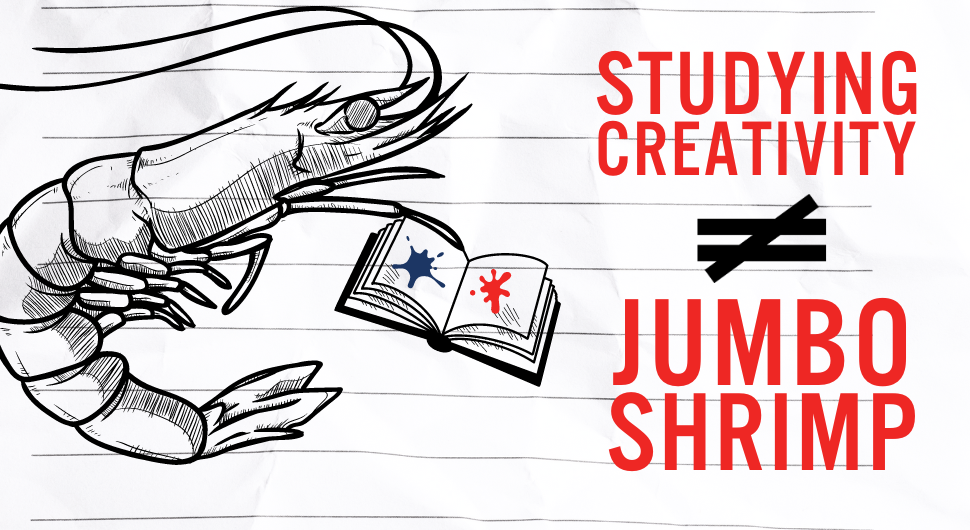Studying Creativity ≠ Jumbo Shrimp
You heard me right. Studying creativity isn’t an oxymoron (no jumbo shrimp here). I mean it. You can become more creative, by simply studying creativity. Are you still with me? Let’s talk about it some more.
For some (bonkers) reason, humanity acts like creativity, artistic ability, and the knack for making cool things is an either/or equation predetermined long before birth. We’ve all heard—and probably said—the old ‘oh, he’s a gifted artist’ or ‘she’s not very crafty.’ But, and I’ll enunciate clearly for those in the back, CREATIVITY CAN BE LEARNED. Studying creativity is not an {oxymoron}.
The {Bittersweet}, {Deafening Silence} of a {Jumbo Shrimp}
I know, bracketing figures of speech is a bit ham-handed. (Which sounds like an oxymoron but isn’t, so it gets a different kind of bracket.) But being labeled either creative or not by some kind of unseen headmaster is frustrating for everyone; those are militant curly brackets.
When it comes to creativity, even the straight-laced Harvard Business Review is open for business, so to speak. They suggest training your brain to be more creative in the same way an athlete trains their muscles. “Creativity isn’t inherent. You have to hone it…Your brain needs fuel, and it needs to be stretched to create those ‘OMG!’ moments on demand. Think about it. Great athletes train their bodies for days, weeks, and years to whip them into peak performance. Why, then, wouldn’t a creator do the same with their brain?”
Performance comes from putting in the work but also from doing the research. A marathon runner doesn’t just binge on any old calories but instead chooses things like carbohydrates that support their specific needs and goals. Like running and stuff like that, or so I’m told. *shrugs* I prefer those treadmills with little TVs built in at the YMCA.
The {Clearly Misunderstood} {Open Secret} of an {Unbiased Opinion}
Neuro-scientifically, the author—himself a card-carrying creative and em-dash fanatic—recommends starting with a few minutes in nature. Outside and phone-free. “Looking at trees and leaves—instead of our electronic devices—reduces our anxiety, lowers our heart rates, soothes us, and allows our brains to make connections more easily…This state sparks our present awareness and fuels our imagination. We are more easily able to connect existing notions, thoughts, and images to form a new, relevant, and usable concept. So make disconnecting a priority.”
He also suggests meditation. “Meditation clears our minds of jumbled thoughts and gives our brains the space to observe and reflect, improving task concentration and enhancing our ability to make smart decisions. But did you know that meditation also puts the entire brain to work? You may have heard that creativity uses your right brain while your left brain is triggered during more analytical tasks. Well, neuroscientists have found that creativity draws on your entire brain—and meditation can give you access to it.”
It’s {Seriously Funny} When You Just {Act Naturally}, said the {Small Crowd}
Once you’ve opened your mind, and your mind’s eye, with nature and meditation, it’s time to put that big brain to work. This is where the author suggests getting on your feet. “Moving around has been linked to increased performance on creative tests. Exercising releases endorphins—chemicals our bodies produce to relieve stress and pain. When we are less stressed, our brains venture into more fruitful territory.”
This doesn’t mean you should ask HR for a treadmill desk or those weird bike pedal thingies for under your chair. Instead, add a daily workout, make time to stretch during each shift, take walks when and where you can, or opt for the stairs instead of the elevator on that midday coffee run.
Then, and here’s something of an oxymoron for many of us freelance types, it’s people’s time. People, especially in the form of high school group project flashbacks, often feel like creativity-slayers but that’s not (always) true. “When consciously seeking inspiration, not enough can be said about diversity. Remember the brain and its predisposition to take the lazy way out? Diversity makes the brain work harder by challenging stereotypes.”
Even if you work remotely, consider finding ways to rub elbows vicariously with other creatives. “Don’t limit yourself by geography when you’re reaching out to someone or expanding your network. We are much better at creative problem-solving when we don’t have the comfort of knowing what to expect, which can happen if we only surround ourselves with people just like us.”
Whether your creative dreams involve art, music, words, or a deliciously fragrant spice rack, never fear! Try new things, then different new things. Then OTHER different new things. Study trends, histories, and crazy theories. Deep dive down the sourdough rabbit hole or backstory of your favorite painter. Practice makes perfect, just not always on the first try.
This work is licensed under a Creative Commons Attribution-ShareAlike 4.0 International License.


